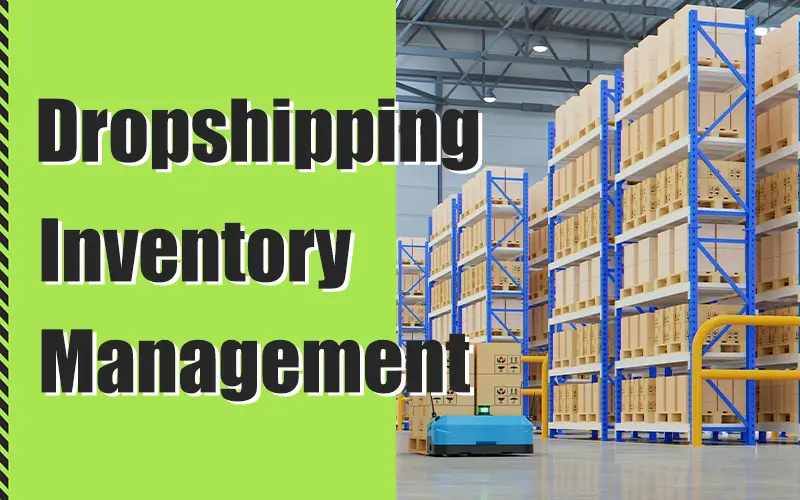Effective dropship inventory management is an important strategy for every dropshipping company. It helps prevent overstocking and lets you keep an eye on stocks that are running low.
Since it relies on real-time data, it helps businesses make informed decisions. With up-to-date information, your inventory levels are always maintained optimally, leading to better customer satisfaction and fewer disruptions.
In essence, dropship inventory management is about striking a balance. Your supplier must have enough stock to meet your customer needs without tying too much capital in inventory.

Page overview:
What is Dropship Inventory Management?
Why Dropshipping Inventory Management is Important
Best Strategies for Effective Dropshipping Inventory Management
2. Use Inventory Management Software
3. Regularly Audit Your Inventory
4. Maintain Strong Supplier Relationships
7. Diversify Your Supplier Base
8. Handle Shipping and Logistics
10. Establish Safety Stock Levels
What Is Dropshipping?
Dropshipping is a business model in which business owners can sell products in their stores without holding inventory. They fulfill orders through a third party who takes charge of packaging and shipping. Dropshipping allows entrepreneurs to start an online store without significant upfront investment in inventory, making it a popular choice for new businesses.
One of the biggest challenges in running an online store is managing inventory since the dropshippers don’t hold inventory. You need to keep track of your stock levels to make sure you have enough products to meet customer demand and avoid overstocking. This can be time-consuming and costly, especially if you’re dealing with a wide range of products.
Therefore, effective inventory management is crucial for your dropshipping business’s long-term success. With effective inventory management, you can focus more on growing your business and less on inventory hassles.
What is Dropship Inventory Management?
Dropship inventory management refers to the process of handling inventory for businesses that are utilizing a dropshipping model. In this kind of setup, the dropshipper does not keep any stock. Whenever a customer buys an item, they will place an order with a supplier who is not directly connected to them – this third party then ships the product straight to said buyer.
- Real-Time Tracking: It’s important to be aware of what products are present. This refers to having real-time information from suppliers. When a product is not available in stock, the shop needs instant knowledge so they don’t sell it.
- A Trustworthy Supplier: Selecting a reliable supplier is very important. This helps the dropshipper to confirm that the supplier can deliver the order in a timely manner. This aids in keeping customers content.
- Order Processing: When a customer makes an order, the retailer must process it swiftly. This step includes transmitting the order details to the supplier and affirming shipment. Automation order processing can save dropshippers time and fewer manual mistakes.
- Handle returns: It is important to offer your customers a clear and concise returns policy that specifies the conditions for accepting returns. A clear return policy is beneficial to smooth return processes, leaving a positive impression on your customers.
- Data Analysis: Scrutinizing sales data may unveil what items are in demand. This can guide retailers in choosing what to highlight or discontinue.

Why Dropshipping Inventory Management is Important?
Running a dropshipping business is not an easy task. Yes, you are spared from managing warehouses packed with products, but this doesn’t imply a complete easeback. Inventory management is still essential even if there’s no physical handling involved. Here’s why it’s so important:
Avoiding the “Out of Stock” and “Overstock” Nightmare
Imagine this: a buyer, full of anticipation, is eager to purchase that interesting toys for their kids from your shop. They press the “buy now” button but discover afterward it is unavailable because it has run out of stock. How disappointing!
Money speaks, doesn’t it? But if you don’t manage your inventory well, it will just walk away from the door. Look at what is being sold and what is not to stop your cash from getting stuck in products that remain idle.
Messy situations like this can be avoided with good inventory management. You’ll always have a clear picture of what is available, making it easier to keep your customers satisfied and returning.
Operational Efficiency
Let’s talk about running your business like a well-oiled machine. Good inventory management is like having a super-efficient personal assistant. It streamlines everything. You’re not wasting time double-checking stock levels or playing phone tag with suppliers.
Instead, you’ve got a system that does the heavy lifting. Think about it. With the right setup, orders flow smoothly from your store to your supplier without you lifting a finger. No more manual data entry or copy-pasting order details. It’s all automatic.
This means you can handle more orders without hiring an army of helpers. And let’s not forget about returns. They’re a pain, right? But with good inventory management, returns can become less of a headache. You can track what’s coming back and why it’s coming back and get it sorted quickly. It’s like having eyes in the back of your head for your business.
Cost Control
Money matters, folks. And in dropshipping, every penny counts. Good inventory management is like having a financial watchdog for your business. It helps you spot where you might be bleeding cash and plug those holes fast.
For starters, it prevents overstocking. You’re not paying suppliers for products that’ll just gather dust in their warehouses. Instead, you’re keeping things lean and mean, ordering only what you know will sell. But it’s not just about saving money.
With solid inventory management, you can spot which products are your real money-makers. You can focus on pushing these winning products and maybe even negotiate better rates with suppliers for bulk orders. And here’s a biggie: avoiding stockouts. Nothing burns cash faster than lost sales because you couldn’t deliver. Good inventory management keeps you on top of stock levels, so you’re always ready to make that sale.
Make Data-Driven Decisions
Gut feelings are great and all, but in business, data is king. And guess what? Good inventory management is a goldmine of data.
With the right system, you can see patterns in your sales. Maybe you sell more pet supplies on Mondays. Or perhaps your fancy gadgets fly off the virtual shelves just before the holidays. This kind of info is pure gold for planning your marketing and stocking strategies.
But it’s not just about what’s selling. It’s also about what’s not. Good inventory management helps you spot the duds in your product line. You can see which items are slow movers and decide whether to drop them or run a promotion to clear them out.
And here’s where it gets really cool. With all this data at your fingertips, you can start predicting the future. Okay, not in a fortune-teller way, but you can make educated guesses about future trends. This means you can stock up on hot items before they sell out or avoid getting stuck with yesterday’s news.

Best Strategies for Effective Dropshipping Inventory Management
Handling inventory in a dropshipping enterprise can be quite challenging. You do not possess physical stock, yet you still have responsibility for making certain your clients receive their ordered items promptly and correctly. This is how you can effectively manage it.
1. Choose Reliable Suppliers
In the initial step, you require reliable suppliers. This is not a situation where it’s appropriate to take shortcuts. Do your research. Check reviews from reliable sources to find suppliers with a good reputation and history. You can also think about making a small test order to see how they handle things.
Trustworthy suppliers give correct stock information, deliver orders on time, and provide good-quality products. They’re your partners in this business, so choose wisely.

2. Use Inventory Management Software
Tracking manually is an act leading to chaos. Spend in excellent inventory management software, it’s like the brain for your business. This can synchronize your shop’s inventory with the supplier’s, handle orders automatically, and keep an eye on sales plus stock levels. It is a time-saver and helps to lessen mistakes.
Good choices are EPROLO, TradeGecko, Skubana, or even the tools within Shopify itself. Pick one that integrates seamlessly with your store and suppliers.
3. Regularly Audit Your Inventory
Even when you have the finest systems, issues can still arise. This is why regular audits are crucial. Save some time for it, perhaps once a month or every three months to double-check your records with those from the supplier.
Check details of products and find out slow-moving items. These reviews assist you in detecting and fixing mistakes in a timely manner, maintaining the steady functioning of your business.
4. Maintain Strong Supplier Relationships
Your dropshipping suppliers are not only providers, they are also partners in your business. Establish strong relations with them and maintain good communication. This helps keep them updated about what you need and answer their questions.
If you have a good relationship, it may mean getting treated as a priority when they are busy, receiving better prices, or having access to inside information about new products or trends – this is beneficial for both parties involved.

5. Set Up Real-Time Alerts
Picture yourself receiving a warning before something goes wrong. This is what real-time alerts accomplish. Arrange notifications for instances such as low stock levels, unexpected surges in demand, or delayed shipments.
These notifications make you quick to respond, like when you need to reorder a popular item or inform customers about possible delays. Taking the first step can help you avoid many problems later on.
6. Forecast Demand
Guessing about future sales may appear like sorcery, yet it is attainable when you possess proper information. You can make use of your past sales data and think about seasonal patterns. Additionally, tools such as Google Trends can offer an understanding of the popularity of products.
Forecasting with precision aids to keep your inventory filled with items that are in demand, preventing excessive stock of those that don’t sell quickly. Accurate forecasting helps you have popular items in stock and avoid overstocking slow movers.
7. Diversify Your Supplier Base
What if the supplier lacks stock or stops doing business? Expand your supply sources to decrease this risk. Arrange secondary suppliers for your main products. If a supplier is unable to meet an order, having backups ready can be compared to having a safety net for your business.
8. Handle Shipping and Logistics
When it comes to shipping, the supplier handles the actual process. Your job is to manage customer expectations by giving them accurate estimates for when their products will arrive and offering tracking information on orders. You must handle any issues or delays in shipping quickly. To guarantee customer satisfaction, working with fast delivery suppliers is a great option.

9. Set a Return Policy
A return policy that is simple to locate and comprehend is important for gaining customer confidence. Clearly define the time frame and conditions for returns. Express the entity that bears return shipping expenses and describe the procedure for refund or exchange. A favorable refund policy can potentially increase purchasing due to lessening customer’s perceived risk.
10. Establish Safety Stock Levels
Safety stock, also known as buffer stock, acts like a cushion to protect you from unexpected events such as sudden increases in demand or problems within the supply chain. For important products, think about having some inventory ready and even organizing for quicker restocking with your supplier.
Examine past sales information and take into account the length of time it usually takes to receive supplies from suppliers when deciding on appropriate levels for safety stock. This helps prevent stockouts and lost sales.
The Best Dropshipping Inventory Management Tool – EPROLO
When it comes to managing inventory in a dropshipping business, having the right tools can make all the difference. EPROLO stands out as one of the best dropshipping inventory management tools available today. Here’s why it deserves your attention.

Seamless Integration
One of the standout features of EPROLO is its ability to seamlessly integrate with various e-commerce platforms like Shopify, Amazon, and others. This integration allows for real-time synchronization of inventory data between your online store and your suppliers.
When a product is sold, EPROLO automatically updates the stock levels, ensuring that you never accidentally sell an item that’s out of stock. This real-time syncing is crucial for maintaining customer trust and satisfaction.
Automation Features
In the fast-paced world of dropshipping, automation is key to efficiency. EPROLO automates many tedious tasks, such as order processing and real-time inventory updates. When a customer places an order, EPROLO can automatically process and fulfill the order.
This not only saves time but also minimizes the risk of human error. You can focus more on marketing and growing your business rather than getting bogged down in administrative tasks.
Comprehensive Inventory Management
EPROLO offers a comprehensive inventory management system that goes beyond just tracking stock levels. It provides detailed insights into your inventory, including product availability, pricing, and features. You can easily discover the popular and lagging items, allowing you to make informed decisions about restocking and promotions.
Warehousing Service
EPROLO also provides robust warehousing services, including product storage, packaging, and shipping. Dropshippers can source products from EPROLO or other suppliers, and stock in EPROLO’s warehouses. They have 26+ global warehouses, enabling fast delivery. This feature allows businesses to store products closer to customers, reducing shipping times and costs.
Branding
No matter whether you want to build your own brand or stand out from the competitive dropshipping world, branding is a perfect option. EPROLO provides dropshippers with branding services. This includes custom labels, hangtags, packaging, etc. By leveraging EPROLO’s branding service, you can connect with your customers and build customer loyalty.

Cost-Effective Solutions
Cost control is a significant concern for dropshippers. EPROLO provides a wide range of products, you can choose from small gadgets to furniture. Besides, they also offer competitive prices. This transparency allows you to maximize your profits while keeping your prices competitive.
User-Friendly Interface
EPROLO is designed with user experience in mind. Its interface is intuitive and easy to navigate, making it accessible for both beginners and experienced dropshippers. You can quickly find the information you need, whether it’s stock levels or order statuses. This ease of use helps you manage your inventory without feeling overwhelmed.
Supplier Network
EPROLO boasts a vast network of reliable suppliers. This means you have access to a wide range of products without the need to manage multiple supplier relationships. You can easily browse through various categories, select products to add to your store, and rely on EPROLO to handle the logistics.
This simplifies the entire dropshipping process and allows you to focus on marketing and customer engagement.
Excellent Customer Support
EPROLO offers solid customer support to help you navigate any challenges you may encounter. Whether you have questions about the platform, need assistance with an order, or require guidance on best practices, their support team is readily available to assist you. This level of support can be invaluable, especially for those new to dropshipping.
Final Thoughts
Effective dropshipping inventory management is crucial for any dropshipping business. It ensures you never overstock, keeps you informed about low stock levels, and helps you make smart, data-driven decisions. By maintaining optimal inventory levels, you improve customer satisfaction and reduce disruptions.
In conclusion, mastering dropshipping inventory management is key to running a smooth and successful business. It balances having enough stock to meet customer demand without over-committing resources. With reliable suppliers, good software, and strong communication, you can handle inventory efficiently.
Remember, even though you’re not storing products yourself, keeping a close eye on your inventory will save you time, money, and headaches in the long run.
FAQs
1. Is it better to dropship or have inventory?
Both dropshipping and having inventory have their set of pros. It depends on your business model, resources, and goals. If you prefer a low-risk and hassle-free model, then dropshipping may be your type. If you want to have resources, and want more control over your products and have resources, maintaining inventory could be more suitable.
2. What are the key challenges of dropshipping inventory management?
The main difference between traditional business and dropshipping is that the latter heavily depends on third-party suppliers. This limited control exists several risks, such as stockout, delayed shipment, and damaged products.
3. How can I keep track of inventory levels when using multiple suppliers?
When working with multiple suppliers, you can try some inventory management software. This helps you automate and streamline the tracking of inventory across multiple suppliers.
Besides, suppliers like EPROLO also provide seamless integration with various platforms, so that they can automatically process and fulfill the order, decreasing manual errors.







